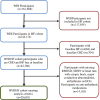Heart rate variability and the risk of heart failure and its subtypes in post-menopausal women: The Women's Health Initiative study
- PMID: 36282885
- PMCID: PMC9595519
- DOI: 10.1371/journal.pone.0276585
Heart rate variability and the risk of heart failure and its subtypes in post-menopausal women: The Women's Health Initiative study
Abstract
Background: Low heart rate variability (HRV), a measure of autonomic imbalance, is associated with increased risk of coronary heart disease (CHD) and heart failure (HF). However, its relationship with HF subtypes; heart failure with preserved ejection fraction (HFpEF) and heart failure with reduced ejection fraction (HFrEF) has not been studied prior.
Methods and findings: We conducted a longitudinal study in Women's Health Initiative study cohort to investigate the association of baseline quartiles of resting heart rate (rHR) and HRV measures; SDNN (SD of normal-to-normal RR interval) and RMSSD (root mean square of successive difference of RR interval) measured by twelve-lead electrocardiogram (ECG) on enrollment, with the risk of hospitalized HF and its subtypes. Total of 28,603 post-menopausal women, predominantly non-Hispanic whites (69%), with a mean (SD) age of 62.6 (7.1) years, free of baseline CHD and HF were included. In a fully adjusted cox-proportional hazards regression model which adjusted for age, race, BMI, alcohol intake, education, physical activity, hyperlipidemia, hypertension, left ventricular hypertrophy, use of beta-blocker, calcium-channel blocker, hormone therapy, and time-varying incident CHD, the hazard ratios of lowest quartile of HRV (Q1) with HF risk were significant (Q1 SDNN compared to Q4 SDNN: 1.22, 95% CI 1.07, 1.39; Q1 RMSSD compared to Q4 RMSSD: 1.17, 95% CI 1.02, 1.33). On subgroup analysis of HF subtypes, low HRV was associated with elevated HFpEF risk (Q1 vs Q4 SDNN: 1.22, 95% CI 1.02, 1.47) but not with HFrEF (Q1 vs Q4 SDNN: 1.19, 95% CI 0.95, 1.50; Q1 RMSSD: 1.13, 95% CI 0.90, 1.43).
Conclusion: Low HRV is associated with elevated overall hospitalized HF risk and HFpEF risk in post-menopausal women. Whether interventions to increase HRV through healthy lifestyle changes will decrease HF risk warrants further investigation.
Conflict of interest statement
The authors have declared that no competing interests exist.
Figures



Similar articles
-
Healthy lifestyle and risk of incident heart failure with preserved and reduced ejection fraction among post-menopausal women: The Women's Health Initiative study.Prev Med. 2020 Sep;138:106155. doi: 10.1016/j.ypmed.2020.106155. Epub 2020 May 28. Prev Med. 2020. PMID: 32473271
-
Risk of heart failure and subtypes with biomarker-calibrated protein intake: Women's health initiative cohort study.Am J Prev Cardiol. 2025 Jul 10;23:101051. doi: 10.1016/j.ajpc.2025.101051. eCollection 2025 Sep. Am J Prev Cardiol. 2025. PMID: 40718583 Free PMC article.
-
Prospective association of obstructive sleep apnea risk factors with heart failure and its subtypes in postmenopausal women: The Women's Health Initiative.J Clin Sleep Med. 2020 Jul 15;16(7):1107-1117. doi: 10.5664/jcsm.8438. J Clin Sleep Med. 2020. PMID: 32209223 Free PMC article.
-
Cardiac autonomic neuropathy and risk of incident heart failure among adults with type 2 diabetes.Eur J Heart Fail. 2022 Apr;24(4):634-641. doi: 10.1002/ejhf.2432. Epub 2022 Jan 31. Eur J Heart Fail. 2022. PMID: 35064959 Free PMC article.
-
Effect of exercise training on heart rate variability in type 2 diabetes mellitus patients: A systematic review and meta-analysis.PLoS One. 2021 May 17;16(5):e0251863. doi: 10.1371/journal.pone.0251863. eCollection 2021. PLoS One. 2021. PMID: 33999947 Free PMC article.
Cited by
-
Test-Retest Reliability and Concurrent Validity of Photoplethysmography Finger Sensor to Collect Measures of Heart Rate Variability.Sports (Basel). 2025 Jan 22;13(2):29. doi: 10.3390/sports13020029. Sports (Basel). 2025. PMID: 39997960 Free PMC article.
-
Evaluation of Pro-BNP biomarker in heart failure patients and its relationship with complete blood count parameters: A case-control study.Health Sci Rep. 2024 Sep 25;7(9):e70083. doi: 10.1002/hsr2.70083. eCollection 2024 Sep. Health Sci Rep. 2024. PMID: 39328979 Free PMC article.
-
Trends in Passive IoT Biomarker Monitoring and Machine Learning for Cardiovascular Disease Management in the U.S. Elderly Population.Adv Geriatr Med Res. 2023;5(1):e230002. doi: 10.20900/agmr20230002. Epub 2023 Mar 31. Adv Geriatr Med Res. 2023. PMID: 37274061 Free PMC article.
-
An association between heart rate variability and incident heart failure in an elderly cohort.Clin Cardiol. 2024 Feb;47(2):e24241. doi: 10.1002/clc.24241. Clin Cardiol. 2024. PMID: 38402572 Free PMC article.
-
Regulation of exercise on heart rate variability in perimenopausal and postmenopausal women.Zhong Nan Da Xue Xue Bao Yi Xue Ban. 2024 Apr 28;49(4):516-525. doi: 10.11817/j.issn.1672-7347.2024.230399. Zhong Nan Da Xue Xue Bao Yi Xue Ban. 2024. PMID: 39019780 Free PMC article. Review. Chinese, English.
References
-
- National Heart, Lung, and Blood Institute, National Institutes of Health: Incidence and Prevalence: 2006 Chart Book on Cardiovascular and Lung Diseases. Bethesda, MD: National Heart, Lung, and Blood Institute; 2006.
-
- Shusterman V, Aysin B, Gottipaty V, Weiss R, Brode S, Schwartzman D, et al.. Autonomic nervous system activity and the spontaneous initiation of ventricular tachycardia. ESVEM Investigators. Electrophysiologic Study Versus Electrocardiographic Monitoring Trial. J Am Coll Cardiol. 1998;32(7):1891–9. doi: 10.1016/s0735-1097(98)00468-9 - DOI - PubMed
-
- Tsuji H, Larson MG, Venditti FJ Jr, Manders ES, Evans JC, Feldman CL, et al.. Impact of reduced heart rate variability on risk for cardiac events. The Framingham Heart Study. Circulation. 1996;94(11):2850–5. - PubMed
MeSH terms
Substances
LinkOut - more resources
Full Text Sources
Medical
Research Materials
Miscellaneous

